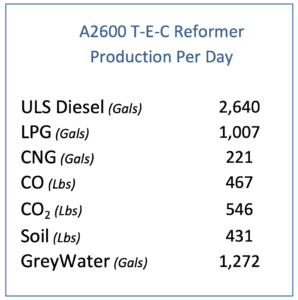The T-E-C Reformer reaction is a low pressure, low heat, continuous process in which complex organic compounds undergo atomic level separation and are reformed into high value hydrocarbon molecules via a Thermal–Electrical–Chemical reaction.
The T-E-C Reformer operates at ambient pressure (15 psia), low temperature (<160o F), and requires minimal levels of external power. The central reaction is a self-contained adiabatic reformation process that generates little external heat and is sustained by the continuous introduction of feedstock. Environmentally friendly, the process generates no hazardous by-products or fugitive emissions.
In contrast to other existing waste-to-energy technologies, the T-E-C Reformer is capable of cost-effectively processing waste streams with moisture content of up to 70%. During the T-E-C reaction Water (H2O) molecules are separated by the reaction into component hydrogen (H) and oxygen (O) reformed with Carbon (C) molecules to produce the liquid hydrocarbon and gas output streams.
The ability to process feedstock with a high Water content greatly increases the range of useable feedstock and eliminates the operating and capital costs associated with dehydrating green or wet feedstock.
Most importantly, the T-E-C Reformer technology is capable of processing a wide variety of biomass: it is equally effective processing animal manures, woody waste, agricultural waste and other cellulosic waste streams.
The T-E-C Reformer technology is less capital intensive, an order of magnitude more efficient, and more easily scaled than conventional waste-to-energy processes. Intrinsically low operating costs, low capital costs and exceptionally high conversion efficiency sets the T-E-C Reformer technology apart from other renewable technologies.
